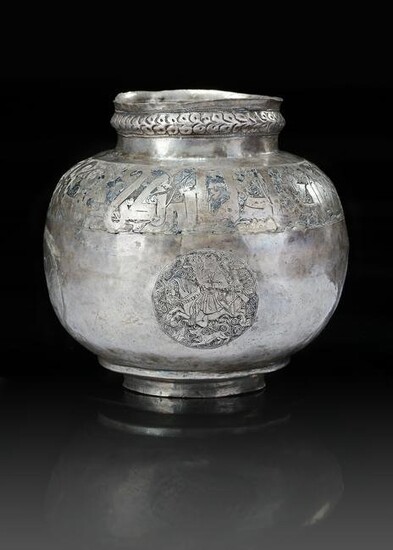A SILVER VESSEL WITH NIELLO, CENTRAL ASIA, 12TH-13TH CENTURY
This sheet-silver container was originally the base and lower neck of a bottle, but at some stage of its history-the neck and mouth were cut off. However, the bottle had already been altered by the addition of a handle, for the outline of part of the lower handle terminal is clearly visible below the calligraphic ornament at the beginning and end of the inscription round the shoulder. It seems likely that the three roundels belong to this period of its history. The Kufic inscription gives the name of the owner, reading: 'Glory, prosperity, wealth and happiness to Abu Bakr Muhammad ibn 'Isa the mattress-stuffer'. We do not know who Abu Bakr Muhammad was, or where he lived, but he had clearly prospered in his mattress stuffing business. The script suggests a dating to the 12th or early 13th century.The three roundels bear a pair of confronted peacocks, a horseman and a fox. The first two motifs are common on Islamic metalwork, though the horseman is carrying an uncommon kind of mace over his shoulder and his face is shown unusually in three-quarter profile. The fox, however, is exceptional. The jackals Kalila and Dimna are found in Islamic art, particularly of course in illustrated manuscripts of the animal fables in which they feature, and foxes are found walking with other animals in the animal friezes which decorate many metalwork objects. Here, however, we have a fox apparently tearing at its own tail. The significance of this image remains to be discovered. The dating of these roundels to the 11th century is suggested by the style of the fox's tail and of those of the peacocks. 12.6 cm. height, 12.8 cm. diam.Accompanied by three metallurgy tests.
[ translate ]Estimate
Time, Location
Auction House
This sheet-silver container was originally the base and lower neck of a bottle, but at some stage of its history-the neck and mouth were cut off. However, the bottle had already been altered by the addition of a handle, for the outline of part of the lower handle terminal is clearly visible below the calligraphic ornament at the beginning and end of the inscription round the shoulder. It seems likely that the three roundels belong to this period of its history. The Kufic inscription gives the name of the owner, reading: 'Glory, prosperity, wealth and happiness to Abu Bakr Muhammad ibn 'Isa the mattress-stuffer'. We do not know who Abu Bakr Muhammad was, or where he lived, but he had clearly prospered in his mattress stuffing business. The script suggests a dating to the 12th or early 13th century.The three roundels bear a pair of confronted peacocks, a horseman and a fox. The first two motifs are common on Islamic metalwork, though the horseman is carrying an uncommon kind of mace over his shoulder and his face is shown unusually in three-quarter profile. The fox, however, is exceptional. The jackals Kalila and Dimna are found in Islamic art, particularly of course in illustrated manuscripts of the animal fables in which they feature, and foxes are found walking with other animals in the animal friezes which decorate many metalwork objects. Here, however, we have a fox apparently tearing at its own tail. The significance of this image remains to be discovered. The dating of these roundels to the 11th century is suggested by the style of the fox's tail and of those of the peacocks. 12.6 cm. height, 12.8 cm. diam.Accompanied by three metallurgy tests.
[ translate ]


